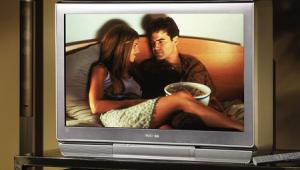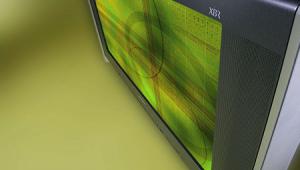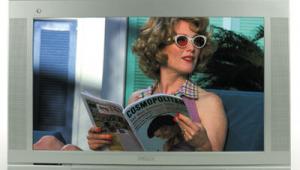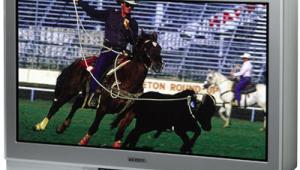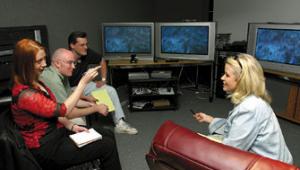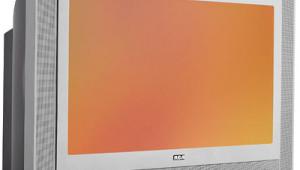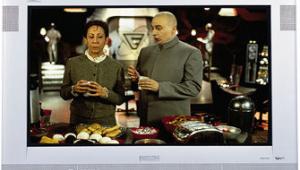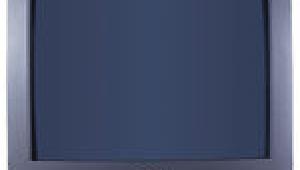The 2002 Direct-View HDTV Face Off Sony KV-34XBR800
There are no two ways about it. Sony got robbed. As Sony is one of the first manufacturers to release a 34-inch direct-view HD monitor, you'd think the company's extended experience in the category would give them an edge over the competition. The XBR line, in particular, is known for quality, and the 800 Series adds some excellent new features. Surprisingly, a dark horse came out in front of what should have won the award for the greatest direct-view TV, ever.

For one, the KV-34XBR800 is one of two futureproof displays in the Face Off. It includes a Digital Visual Interface (DVI) with High-Bandwidth Digital Content Protection (HDCP) for connection to an HDTV tuner (such as Sony's SAT-HD200) that has a DVI output. This feature in and of itself makes the set worth considering. Plus, the DVI input is just one of seven inputs: There are six on the back panel and one on the front, which is more than any other contestant. This should be more than enough connections for most advanced systems, although the lack of an RGB input might restrict the TV's use in some cases.
You can use the toggle button on the well-laid-out remote to switch between inputs. Discrete commands for each input  and for power on and off would be more convenient, as would some form of backlighting. This is a home theater product, folks. Home theaters are dark places. The controller has an aspect-ratio button, but you may not need to use it, as the KV-34XBR800 is one of the few TVs that can read a DVD's anamorphic aspect-ratio flag and automatically switch to the appropriate setting. Maureen also liked the remote's flip lid, which hides lesser-used functions and gives the remote a less-cluttered look. Geoffrey, Chris, and Claire just said, "Eh." They were neither enthused nor appalled. As Geoffrey put it, "It's a standard, solid Sony remote."
and for power on and off would be more convenient, as would some form of backlighting. This is a home theater product, folks. Home theaters are dark places. The controller has an aspect-ratio button, but you may not need to use it, as the KV-34XBR800 is one of the few TVs that can read a DVD's anamorphic aspect-ratio flag and automatically switch to the appropriate setting. Maureen also liked the remote's flip lid, which hides lesser-used functions and gives the remote a less-cluttered look. Geoffrey, Chris, and Claire just said, "Eh." They were neither enthused nor appalled. As Geoffrey put it, "It's a standard, solid Sony remote."
I will say that the picture-mode toggle is a nice bonus. While you can't save the picture settings for each input, you can at least save different picture settings to four preset picture modes. Unfortunately, the modes use names like vivid, standard, movie, and pro. If you can't remember that your HDTV input uses the vivid mode and your DVD input uses the movie mode, you're screwed.
 Making changes to these modes using the onscreen menu is easy, thanks to the menu's combination of graphics, text, and intuitive layout. Changes are a little harder to perform, though, as the menu consumes much of the screen. Fortunately, the menu offers considerable flexibility. For example, you can disable the set's SVM (Sony calls it ClearEdge VM) and fine-tune the picture controls for a reasonably accurate image. SVM tends to enhance the image's apparent detail and brightness at the expense of real detail. The image looks best when SVM is off, but the ability to change the setting is welcome. The Sony's DC restoration, or its ability to keep dark images consistently dark while the overall brightness changes, is also fairly good. It was more accurate in the movie mode than in the other modes. Before calibration, the color decoder exaggerated reds slightly, but not enough to annoy any of the panelists. Most of us agreed with Maureen's assessment that the image was just too blue, even in the warm color-temperature setting. Chris dissented. As a KV-36XBR450 owner, he appreciated this set's attributes. After calibration, the color level was substantially more accurate and offered one of the most natural-looking pictures in the group. Remarkably, this had much less of an impact on the judging panel than I expected.
Making changes to these modes using the onscreen menu is easy, thanks to the menu's combination of graphics, text, and intuitive layout. Changes are a little harder to perform, though, as the menu consumes much of the screen. Fortunately, the menu offers considerable flexibility. For example, you can disable the set's SVM (Sony calls it ClearEdge VM) and fine-tune the picture controls for a reasonably accurate image. SVM tends to enhance the image's apparent detail and brightness at the expense of real detail. The image looks best when SVM is off, but the ability to change the setting is welcome. The Sony's DC restoration, or its ability to keep dark images consistently dark while the overall brightness changes, is also fairly good. It was more accurate in the movie mode than in the other modes. Before calibration, the color decoder exaggerated reds slightly, but not enough to annoy any of the panelists. Most of us agreed with Maureen's assessment that the image was just too blue, even in the warm color-temperature setting. Chris dissented. As a KV-36XBR450 owner, he appreciated this set's attributes. After calibration, the color level was substantially more accurate and offered one of the most natural-looking pictures in the group. Remarkably, this had much less of an impact on the judging panel than I expected.
Sony's internal video processor, called Digital Reality Creation (DRC), detects the 3:2 frame sequence of video images that are sourced from 24-frame film through the component and S-video inputs, making those images smooth and free of artifacts. Composite signals do find the 3:2 sequence, but not as quickly as with the other signals. Although DRC didn't create as sharp a picture as Philips' Pixel Plus, Claire pointed out that it didn't create as many annoying artifacts, either. In fact, DRC is much more flexible. A user-adjustable menu graph changes the level of apparent detail or reality (on the y-axis) and smoothness or clarity (on the x-axis). You can also make changes without affecting other picture settings.
There's no way to hide it: Sony got snookered. With a little adjustment, the KV-34XBR800 provides a good picture. In the skilled hands of a knowledgeable service technician, the image is the most accurate of all of the sets in the Face Off. Normally, this would be enough to win over our discriminating crowd. Combine this with excellent features like the DVI input, automatic aspect-ratio control, and 3:2-pulldown recognition, and you have, hands down, a winning combination. Well, you'd have a winning combination in some other competition, but apparently not in this one. For some reason, Chris and I were the only ones who picked this set to be top dog; and, even then, I almost cast my vote for the Philips. It just goes to show you that accuracy doesn't always reign supreme. If you want the most accurate display available, though, you know where to look.

KV-34XBR800 HD Monitor $2,499
Sony Electronics
(800) 222-SONY
www.sony.com
Dealer Locator Code SNY
Highlights
• 3:2-pulldown recognition
• Auto aspect-ratio detection
• DVI input
HT Labs Measures: Sony KV-34XBR800


The top chart shows the gray scale of the KV-34XBR800 HD monitor as set by the manufacturer in the low color-temperature setting. The set measures about 7,800 Kelvin across most of the range. After making adjustments using the Photo Research PR-650, the gray scale measures within 60 degrees of D6500, the accurate setting, across the entire range. This is excellent. The bottom chart shows that the primary colors of the display's CRTs are fairly close to those specified by SMPTE. This means that the display will reproduce most of the colors available in the system. The gray scale measures blue before calibration and is extremely accurate afterward. The light output was approximately 23 foot-lamberts. The display has good DC restoration. The set's color decoder pushes red, but only slightly, and this can be calibrated in the service menu by a qualified technician. The set displays about 1,150 horizontal pixels with the 1080i test pattern from our Leader LT-446 HDTV test-pattern generator.—MW
- Log in or register to post comments
